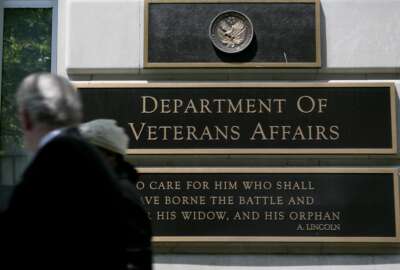Hubbard Radio Washington DC, LLC. All rights reserved. This website is not intended for users located within the European Economic Area.
Costly, complex, weaknesses: Not great words for VA’s electronic health record project
The new EHR has proven to be a heavy lift, especially when it comes to a realistic and enforceable schedule.
Best listening experience is on Chrome, Firefox or Safari. Subscribe to Federal Drive’s daily audio interviews on Apple Podcasts or PodcastOne.
Mama never said it would be easy. Department of Veterans Affairs officials knew they were taking on a long and expensive project when back in 2017, they decided to replace VistA, the electronic health records and management system. The new EHR has proven to be a heavy lift, especially when it comes to a realistic and enforceable schedule. The Federal Drive with Tom Temin got the latest report from VA’s Deputy Inspector General David Case.
Interview transcript:
Tom Temin: Mr. Case, good to have you on.
David Case: It’s great to be here. Thank you.
Tom Temin: And you looked at the issue of whether it has a, what is considered a best-practice across the government, an integrated master schedule that everybody follows. Did you find that this project doesn’t have one? Does it have one they’re not following? Or, does it have one they’re not very good at following?
David Case: I would characterize it this way, they have a start of an integrated master schedule, but it only runs through 2023 March. And it only covers at this point about 20 of the sites – 20 of the 170, So they have a start, but even what they have is not reliable, because it just doesn’t meet the standards that GAO and others have put out there and that VA has adopted. So there’s a big blank time period that’s not there, 2023 forward, and what’s in there just does not meet the necessary standards.
Tom Temin: Could it be that they thought they’d be done by ’23?
David Case: No, even the projections they sent to Congress early on in the process, look to 2028 as the completion date.
Tom Temin: All right, and just briefly, what are the elements that should be in a good integrated master schedule plan?
David Case: Well, there’s really four key elements that are part of any integrated master schedule that is going to be reliable. First, it has to be comprehensive. That means it goes from start to finish. And it includes all aspects of work that needs to be done by contractors, by VA and its various component. And it should be as comprehensive as possible. We realize that it’s tough to know what’s exactly going to be done in years 7, 8, 9 or 10. But you can put in what you know has to be done at this point. So for instance, for every site, we know there’s going to have to be training, fiscal upgrades, and then you can add to that as you go forward and learn more. So it needs to be comprehensive, that’s the first aspect. The second aspect needs to be credible. And that means there needs to be some associated risk analysis. And that gives you a sense of what’s your best case, worst case, and your most likely case to tell you if you’re going to get it done on time. And there’s just two other aspects to it. One, it needs to be well-constructed. And that means it has what’s called a critical path. That means it flows from A to B to C to D, and it gives you the earliest time that the project can get done. And that allows you to measure what delays will cause at the end of the project. And finally, it needs to be controlled. There should be a baseline that you’re always measuring. So those four aspects are really the key parts: comprehensive, credible, well-constructed, control.
Tom Temin: And who is responsible for this? Because the report seems to imply, or state rather I should say, that the contractor Cerner is also a partner in the creation of a credible and useful schedule.
David Case: Right. That’s a good question. Ultimately, VA is responsible to have this in place and make sure it’s followed. Now they can contract out parts of it or all of it. But they need to be sure that it’s being done up to necessary standards. Otherwise, they can’t assess the progress, they can’t identify problems, they can’t identify resolutions, and they can’t really hold people accountable. So in the way it’s set up, Cerner does have a role in this, but ultimately, VA is responsible.
Tom Temin: Well, what does VA have to do then at this point? Because it is way behind schedule and there are lots of technical issues with it, technological issues and usefulness issues, which I think you’ve detailed in other reports, as has the GAO and just about everybody else in town. But what, with respect to the schedule, can they get this back on track at this point?
David Case: Well, we won’t know until they get an integrated master schedule done. That’s the key aspect to it. They need to map this out from where they’re at now to 2028 if that’s still the completion date, and so that way they can assess, outsiders can assess where they are and can they get this completed, and do they have all the necessary components in place to get it completed? So really finishing this integrated master schedule and making it a reliable schedule is the key part of them, assessing and others assessing where they stand?
Tom Temin: We’re speaking with David Case, the Deputy Inspector General of the Veterans Affairs Department. And this lack of schedule, lack of professionally-done schedule, let’s say, what are some of the other effects that it could have on the project besides the project being over-scheduled or late?
David Case: First of all, without the schedule, you can’t tell where you stand. And what needs to be done, do you need be more resources in one area, another area, what needs to be solved first? That’s that critical path approach. Do we need this to be solved before we can move on to other things? Second, because you can’t really assess where you stand on the schedule in completion, it potentially impacts the budget. If they can’t get it done by 2028, every year thereafter, in our estimation, is going to cost another $1.95 billion. So there’s a lot of ramifications and how you schedule your work resources to apply. There’s just a lot of detailed ramifications.
Tom Temin: Right. And as you implied earlier, when you stated all of the elements that have to be in a schedule, there could be things that are not done. So it could be on schedule, but “oops, we missed a few things.”
David Case: Exactly. It can act as a checklist, in a broad sense. Are you getting the work done that needs to be done, and measuring how long it takes to get it done? So it might have taken me six months for this project in this particular site and year five, that I have to plan it for a similar site in the year eight, it’s going to take roughly that period of time, unless I found some way to make it faster.
Tom Temin: Now they do have two or three deployments. They’ve been rocky, but they have them at this point so they’re not at zero. But what is required for the project as it stands to be able to create this integrated master schedule at this point? And I think VA officials agree they need to do that. Do they have to stop, kind of cold on the work going on to create that schedule and then resume?
David Case: Yup. I think they recognize they need to do work, as you said, on the Integrated Master Schedule. It’s really a dedication to the task is what I would call. You need to apply their resources to do it, and to take the lessons you’ve learned from your first three deployments, the work you’re doing to correct and identify problems, solving some of the recommendations the IG has made, and then map that into your schedule. And then, once again, a critical component is that risk analysis. What’s the risk in the schedule? You really can’t do that until, it’s a complicated effort until you have a process in place and you have something you can perform a risk analysis on.
Tom Temin: Who should be involved here? Because the technical ends of the project, that’s a OCIO-kind of function. But it’s really not them alone, that should be part of the schedule, I don’t imagine.
David Case: That’s correct, they’ve got to incorporate all the various components in the process. [The Veterans Health Administration] has a role in this. Yes, there’s a lot of technical aspects, we need to understand what the contractors are doing, or they need to understand and really gotta incorporate all those and analyze them and put them in a schedule. And then that way, you can see where the problems might lie, what you have to work around and plan towards.
Tom Temin: And a project of this scope and complexity, you don’t have a master schedule or project plan that’s on a whiteboard in somebody’s office. Aren’t there electronic tools that are pretty sophisticated, to support something at this level? And I guess the secondary question to that one is, would it be worth their while to have a contractor take over the program management and the schedule?
David Case: Well, that’s a decision they’re going to have to make from a business perspective. I mean, they have their own resources, they have to assess the skills they have, the technical tools they have, what the contractors can bring to the effort, and right now it’s a mix of both, there’s nothing wrong with that. They’re just going to have to continue to analyze whether this is the most efficient way to construct the schedule, and then monitor. The schedule can be modified, you’ll learn as you go. So they can do a new iteration, they should archive the old one so they can see where they were at and what the changes are. But it can be a mix of VA resources, contractor resources, it’s going to have to involve various components at VA and doing this and you’re right, it is a very complicated process. Even as I indicated, the risk analysis is a very complicated technical output.
Tom Temin: And other than the recommendation to establish an integrated master schedule, what other major specific recommendations did you have for VA here?
David Case: Yeah, we’ve had a couple here. First of all, they just need to work towards that end, and that’s a critical part of it. There are other aspects to it that we recommended, what we call stakeholder coordination, they really need to get VHA, [the Office of Information and Technology], [the Veterans Benefits Administration] involved. Once again, I keep circling back they need to once they get this in place, they need to get a process and procedure going for a risk analysis. They need to ensure that there’s a coordination between the work breakout schedule and the Integrated Master Schedule. We’ve recommended that they make their contract requirements clear. And then there was one finding, there were some iterations of the integrated master schedule that have been done so far, that were paid for before they were accepted. And they need to be acceptance, determine if they’re up the quality before they’re paid for. And VA’s committed to go forward and do all these things. And so we’ll monitor that and they’ll get evidence that they’re accomplishing that.
Tom Temin: Right. The program office essentially agreed with what you found and recommended.
David Case: Yes, that’s correct. But they had their stand-down period and then issued and the lessons learned in July 2021. Once again, at that point, they also realized they need to move forward and do a better job with the Integrated Master Schedule.
Tom Temin: David Case is deputy inspector general of the Veterans Affairs Department. Thanks so much for joining me.
David Case: I appreciate it. Thank you very much.
Copyright © 2024 Federal News Network. All rights reserved. This website is not intended for users located within the European Economic Area.
Tom Temin
Tom Temin is host of the Federal Drive and has been providing insight on federal technology and management issues for more than 30 years.
Follow @tteminWFED





